

Jupiter will climb a little higher in my skies this year compared to last. The notable thing to notice in the images below is that the south equatorial belt has returned (see my images from last year). The other thing to note is that Jupiter is moving away from its equinox towards summer in the northern hemisphere. Since the four major satellites revolve in Jupiter's equatorial plane, this means that shadow transits are becoming rarer, and Callisto, the most remote of the four, no longer produces them and does not transit the planet as seen from Earth. Ganymede can just produce shadows very close to the south pole and can just transit and be occulted by Jupiter. I have tried to illustrate these phenomena in the pictures below, which are in chronological order.
In March 2003 I imaged a shadow transit of Callisto when the shadow passed almost exactly along the equator, so Jupiter must have been at equinox in the spring of 2003. Its period of revolution is 11.86 years, so it will be back there in January 2015, and should have been at solstice in January 2011. Indeed I have a picture of a shadow transit of Ganymede dated 16 September 2010 showing it passing well into the southern hemisphere of Jupiter. However a planetarium program indicates that shadow transits of Ganymede never actually ceased but became minimal in September 2010, so my estimate of January was a bit out.
One other matter of interest is that a few years ago, when I was imaging with a webcam (the Toucam 740K, which remains probably the best webcam for the purpose), I would have said that it was not possible to capture both the satellites and details on the planet in the same exposure, until I finally achieved it by careful manipulation of exposure, gain, and gamma on 24th February 2004 (bottom image here). Now with the DFK camera, it is almost routine, although I still use composite images sometimes to bring out the satellites more clearly (and I make this clear in the description).
For some images extra information is available if you move your mouse over the image.
The next picture is rather large, but I was pleased with it. It is both a mosaic and a composite because, firstly, I could not fit all the scene onto the camera and, secondly, I over-exposed the pictures of the satellites and superimposed a correctly-exposed picture of Jupiter.
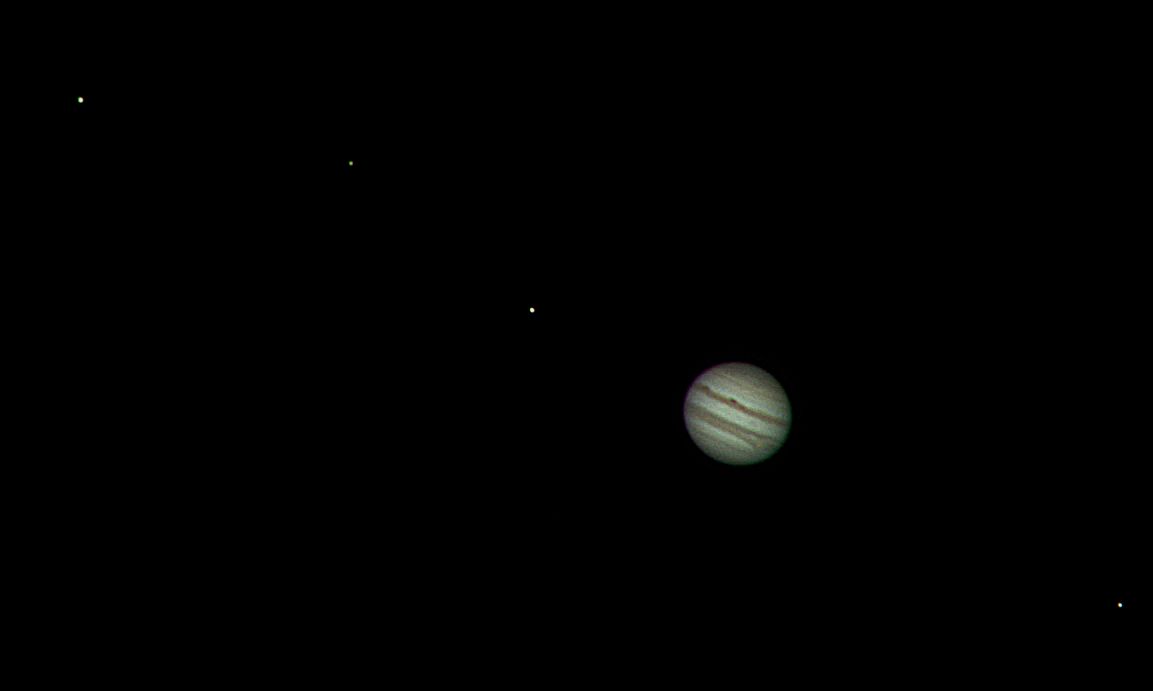
Date and Time: 15th October 2011, 03:31 to 03:38 UT
Camera: DFK 21AF04
Telescope: LX200 at prime focus
Capture: ICCapture. Jupiter 1/500", satellites 1/120", gain 1023, 1635 frames captured
Processing: Registax6. Jupiter 100 frames stacked. Wavelets 2-3 = 10, histogram 20-255
Satellites 100 frames stacked. Wavelets 1-2 = 10, histogram 25-255.
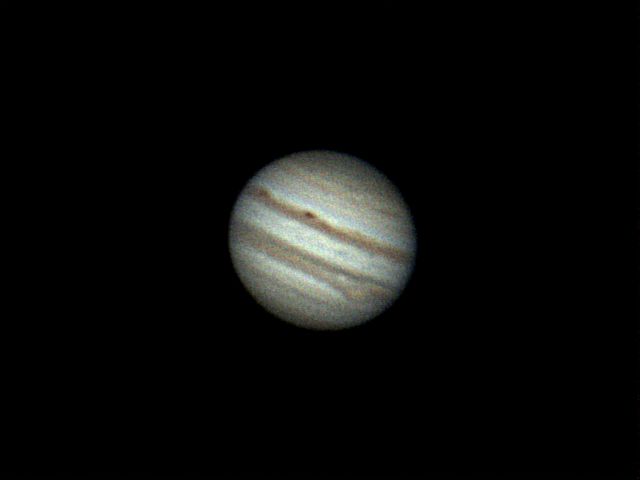 |
And here is a larger-scale image of Jupiter, taken the same night as the picture above. Date and Time: 15th October 2011, 03:41 UT Camera: DFK 21AF04 Telescope: LX200 with X2 adaptor lens Capture: ICCapture. 1/154" gain 1023 Processing: Registax6. 4 alignment points, 100 frames stacked per alignment point, Wavelets 1-3 = 10, histogram 12-160. |
And here another full-scale image of the Jupiter family, again a composite.
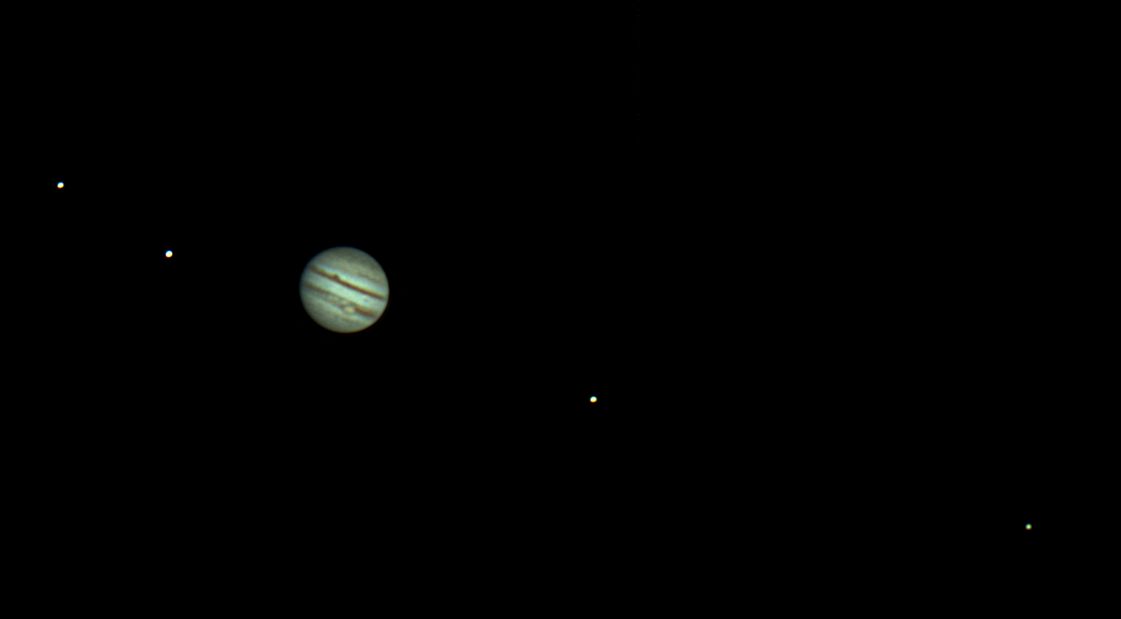
Date and Time: 3rd January 2012, 18:56 UT
Camera: DFK 21AF04
Telescope: LX200 at prime focus
Capture: ICCapture. Jupiter 1/367", satellites 1/30" gain 905
Processing: Registax6. A single alignment point for Jupiter, one for each satellite for the satellite images. 100 frames stacked per alignment point, wavelets 1-3 = 10.
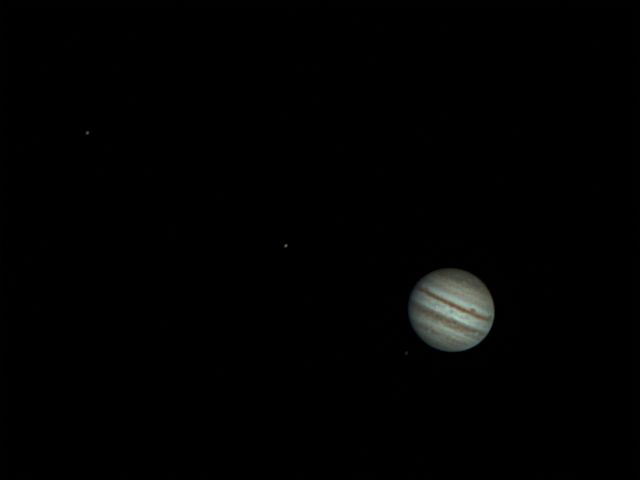 |
This picture illustrates how Callisto passes below the south pole as seen from here. Date and Time: 13th January 2012, 19:25 UT Camera: DFK 21AF04 Telescope: LX200 Capture: ICCapture. 1/183" gain 751 Processing: Registax6. 4 alignment points, 100 frames stacked per alignment point, wavelets 1-2 = 10. | |
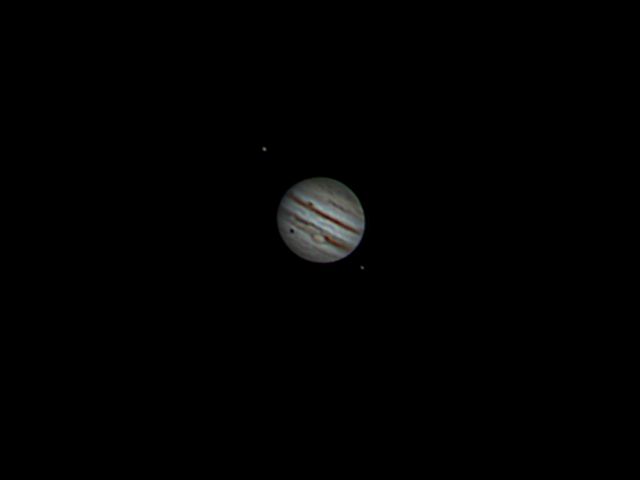 |
And now, the next day, a shadow transit of Europa. See how it will pass south of the Great Red Spot. Date and Time: 14th January 2012, 22:49 UT Camera: DFK 21AF04 Telescope: LX200 Capture: ICCapture. 1/38" gain 410 Processing: Registax6. 2 alignment points, 200 frames stacked per alignment point, wavelets 1-3 = 10, Focus Magic 4,100. |